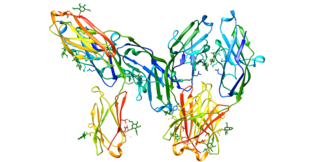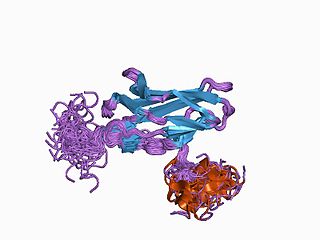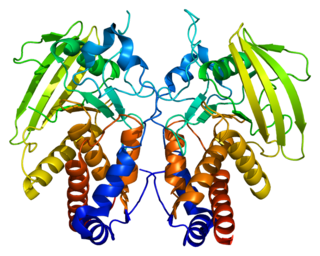
CD33 or Siglec-3 is a transmembrane receptor expressed on cells of myeloid lineage. It is usually considered myeloid-specific, but it can also be found on some lymphoid cells.

Acute myeloblastic leukemia with maturation (M2) is a subtype of acute myeloid leukemia (AML).

The related to receptor tyrosine kinase (RYK) gene encodes the protein Ryk.

Runt-related transcription factor 1 (RUNX1) also known as acute myeloid leukemia 1 protein (AML1) or core-binding factor subunit alpha-2 (CBFA2) is a protein that in humans is encoded by the RUNX1 gene.

MN1 is a gene found on human chromosome 22, with gene map locus 22q12.3-qter. Its official full name is meningioma 1 because it is disrupted by a balanced translocation (4;22) in a meningioma.

Platelet-derived growth factor receptor beta is a protein that in humans is encoded by the PDGFRB gene. Mutations in PDGFRB are mainly associated with the clonal eosinophilia class of malignancies.

Homeobox protein Hox-A9 is a protein that in humans is encoded by the HOXA9 gene.

Core-binding factor subunit beta is a protein that in humans is encoded by the CBFB gene.

Protein CBFA2T1 is a protein that in humans is encoded by the RUNX1T1 gene.

Amyloid-like protein 1, also known as APLP1, is a protein that in humans is encoded by the APLP1 gene. APLP1 along with APLP2 are important modulators of glucose and insulin homeostasis.

Disks large-associated protein 5 (DAP-5) also known as discs large homolog 7 (DLG7) or hepatoma up-regulated protein (HURP) is a protein that in humans is encoded by the DLGAP5 gene.

Ubiquitin-conjugating enzyme E2 G2 is a protein that in humans is encoded by the UBE2G2 gene.

ATP-binding cassette sub-family A member 3 is a protein that in humans is encoded by the ABCA3 gene.

Phosphatidylinositol binding clathrin assembly protein, also known as PICALM, is a protein which in humans is encoded by the PICALM gene.

Protein ariadne-2 homolog is a protein that in humans is encoded by the ARIH2 gene.

Ubiquitin-conjugating enzyme E2 G1 is a protein that in humans is encoded by the UBE2G1 gene.

Receptor-type tyrosine-protein phosphatase O is an enzyme that in humans is encoded by the PTPRO gene.

Ubiquitin-like modifier-activating enzyme 7 is a protein that in humans is encoded by the UBA7 gene.

Protein ENL is a protein that in humans is encoded by the MLLT1 gene.

DnaJ homolog subfamily C member 2 is a protein that in humans is encoded by the DNAJC2 gene.






















